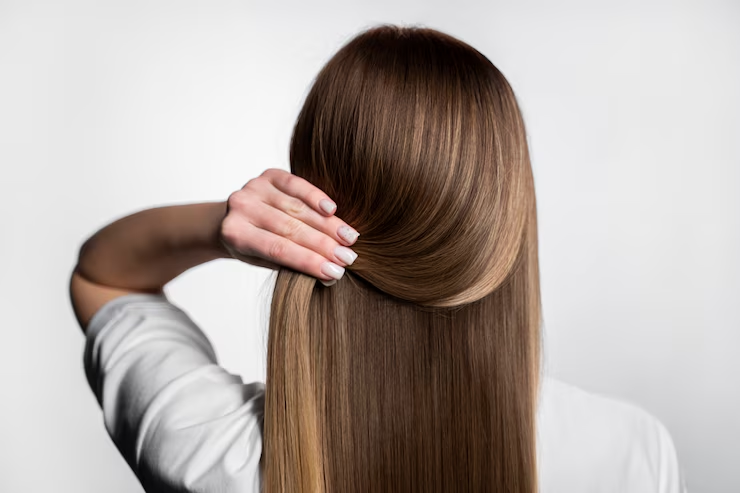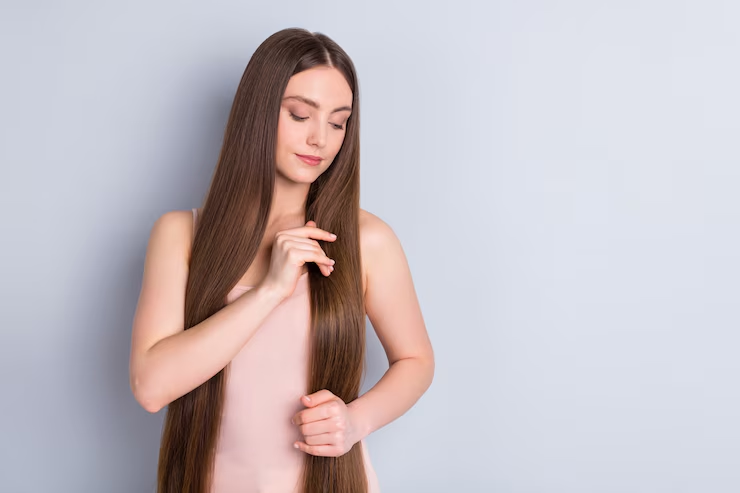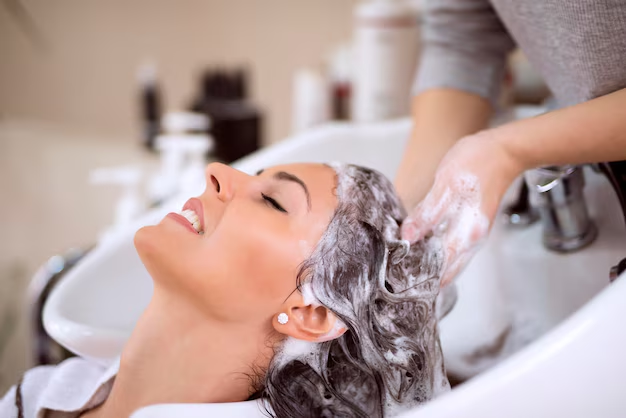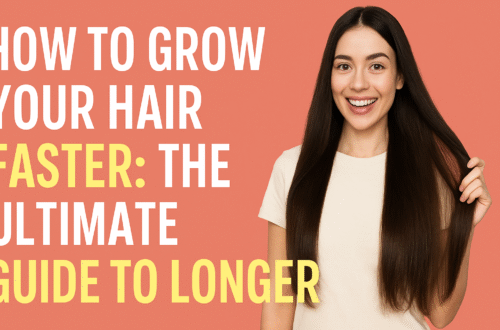Silky hair is something many people long for — that soft, smooth, and shiny look that moves effortlessly and glows in the light. While it might seem like only a lucky few are born with naturally silky hair, the good news is that achieving it is possible for almost everyone. Genetics do determine your natural hair type and texture to some extent, but daily habits and proper care play an even bigger role in how your hair looks and feels.
To get silky hair, you need to focus on keeping your hair healthy from the inside out. This means using the right shampoos and conditioners, avoiding excessive heat styling, and choosing nourishing treatments that repair and strengthen each strand. Incorporating a balanced diet rich in vitamins and minerals is also crucial since your hair’s health starts from within. Hydration, gentle handling, and regular trims further support the journey to smoother, silkier strands.
With the right approach and consistency, anyone can transform dry, rough, or frizzy hair into beautiful, silky hair that feels soft to the touch and shines brilliantly. By making small but impactful changes to your routine, you can enjoy hair that looks as luxurious as it feels, boosting both your confidence and overall style
In this comprehensive guide, we’ll explore what makes hair silky, the science behind hair health, common mistakes that make hair rough or frizzy, and the top 8 tips to achieve and maintain silky hair. Whether you have straight, wavy, curly, or coily hair, these strategies can help you transform your hair into its healthiest, glossiest version.
What Makes Hair Silky?

Silky hair is admired for its smooth, soft feel and gorgeous, light-reflecting shine. When you run your fingers through truly silky hair, it glides effortlessly without snagging or tangling. This luxurious texture is a sign of strong, healthy hair and is often the result of a consistent, mindful hair care routine. Achieving this smoothness isn’t just about external products — it involves nourishing your hair from the inside out and protecting it from daily damage.
At the core of silky hair is the cuticle layer, which is the outermost protective layer of each hair strand. When the cuticle is healthy and lies flat, it creates a smooth surface that reflects light beautifully, giving hair that sought-after glossy finish. If the cuticle is rough or damaged, hair tends to look dull, feel coarse, and become prone to tangles and frizz.
To maintain silky hair, it’s crucial to focus on practices that keep the cuticle sealed and smooth. This includes using gentle shampoos, deep conditioning regularly, minimizing heat styling, and protecting hair from harsh weather and pollution. By prioritizing hair health and adopting the right habits, anyone can enjoy hair that not only looks stunning but also feels soft and luxurious every day.
When the cuticle layer lies flat, hair strands slide past each other easily, feel soft, and are less likely to get damaged. On the other hand, when the cuticle is rough or lifted (often due to heat, chemicals, or dryness), hair looks dull, feels coarse, and becomes prone to breakage.
Common Reasons Hair Loses Its Silky Texture
Before we dive into how to achieve silky hair, it’s important to understand why hair might lose its smoothness:
- Heat damage: Frequent use of straighteners, curling irons, and blow dryers at high heat can roughen the cuticle.
- Chemical treatments: Dyeing, bleaching, and chemical straightening or perming can weaken and strip the hair.
- Harsh shampoos: Sulfates and strong detergents can strip natural oils that keep hair soft.
- Environmental stress: UV rays, pollution, wind, and hard water all contribute to roughness and frizz.
- Poor nutrition: Hair needs adequate protein, vitamins, and minerals to stay strong and silky.
- Improper handling: Vigorous towel drying, rough brushing, and tight hairstyles can all damage hair fibers.
The Science of Silky Hair

Hair is primarily made of keratin, a type of protein, and its outermost layer, the cuticle, resembles overlapping scales on a fish. When these scales are smooth and lay flat, hair feels silky and appears shiny. Moisture balance, proper nutrition, and gentle care are key to keeping the cuticle healthy and smooth.
Healthy sebum, which is your scalp’s natural oil, plays a crucial role in achieving silky hair. This natural oil travels down the hair shaft, coating each strand to add shine, softness, and a smooth, manageable texture. Sebum acts as a protective barrier, locking in moisture and preventing hair from becoming dry, brittle, or frizzy. When this natural process is supported, hair not only looks shinier but also feels stronger and more resilient.
However, many people make the mistake of washing their hair too frequently or using harsh shampoos and products that strip away these beneficial oils. Over-washing removes sebum before it has a chance to protect and nourish your strands, leading to dryness and loss of natural shine. Products containing strong sulfates or alcohol can further disrupt this balance, making it difficult to maintain silky hair and contributing to roughness or split ends.
To keep silky hair, it’s essential to find the right balance between cleanliness and moisture. Aim to wash your hair only when needed, using gentle, sulfate-free shampoos that preserve natural oils. Incorporating moisturizing conditioners and leave-in treatments can further support a healthy, smooth texture. By respecting your scalp’s natural oil production, you can enjoy long-lasting, radiant, and truly silky hair.
Top 8 Tips for Achieving Silky Hair
1. Choose the Right Shampoo and Conditioner
One of the most important steps toward silky hair is using gentle, sulfate-free shampoos. Sulfates are harsh detergents that strip your hair of natural oils, leaving it dry and rough. Instead, opt for moisturizing shampoos with natural ingredients like aloe vera, argan oil, or coconut milk.
Conditioning is equally important. A good conditioner smooths the cuticle and helps lock in moisture. Look for conditioners rich in natural oils, proteins, and humectants like glycerin. Apply conditioner mainly on the lengths and ends, avoiding the scalp if you have oily hair.
2. Minimize Heat Styling
Excessive heat styling is one of the most common reasons people struggle to achieve or maintain silky hair. High temperatures from blow dryers, flat irons, and curling irons can damage the hair cuticle, causing it to lift and become rough. Once the cuticle is compromised, hair loses its natural smoothness and shine, leading to frizz, dryness, and breakage. While these styling tools can create beautiful looks temporarily, overusing them often results in long-term damage that makes silky, healthy hair feel impossible to achieve.
To keep silky hair, it’s important to minimize your use of high-heat styling tools as much as possible. Embrace air drying when you can, or choose gentler heat settings if you must style your hair. Switching up your hairstyles to include more natural textures or heat-free options can also give your strands a much-needed break and help restore their natural softness and luster.
When you do decide to use heat, always apply a heat protectant spray or serum first. These products form a protective barrier around each strand, reducing the risk of cuticle damage and moisture loss. By being mindful about how you style, you can enjoy the best of both worlds: beautifully styled looks and naturally silky hair that shines with health.
If possible, let your hair air-dry. If you must blow-dry, use the cool or medium setting and keep the dryer at least 6 inches away from your hair.
3. Regular Deep Conditioning and Hair Masks
Weekly or bi-weekly deep conditioning treatments or hair masks are powerful tools for achieving and maintaining silky hair. Unlike regular conditioners, these intensive treatments are designed to penetrate deeper into the hair shaft, delivering a higher concentration of nourishing ingredients. They help restore lost moisture, repair damage from heat or chemical styling, and strengthen hair from the inside out. By replenishing hydration and sealing the cuticle, these masks leave your hair feeling softer, smoother, and more manageable.
If you want truly silky hair, adding a deep conditioning treatment to your routine can make a significant difference. Ingredients like shea butter, argan oil, coconut oil, honey, and keratin work to deeply hydrate and repair hair, transforming dry or rough strands into sleek, shiny locks. For the best results, apply your chosen mask to clean, damp hair, leave it on for at least 20–30 minutes, and then rinse thoroughly.
Incorporating this self-care step not only supports healthier hair but also creates a relaxing, spa-like experience at home. Over time, consistent deep conditioning helps improve elasticity, reduce breakage, and enhance your hair’s natural shine. By making this habit a part of your weekly routine, you’ll be on your way to stronger, more beautiful, and irresistibly silky hair.
Choose masks with ingredients like shea butter, coconut oil, keratin, honey, or avocado oil. Apply generously to damp hair, leave on for at least 20–30 minutes (or longer if possible), and rinse thoroughly.
4. Eat a Hair-Friendly Diet

What you eat has a huge impact on your hair’s overall health, strength, and shine. If you’re aiming for silky hair, focusing on a balanced, nutrient-rich diet is just as important as using the right products. Your hair is primarily made of protein, so including enough high-quality protein in your meals is essential for promoting stronger, healthier strands. Foods like eggs, fish, lean meats, legumes, and nuts provide the building blocks needed for hair growth and repair, helping you achieve that smooth, touchable softness.
In addition to protein, healthy fats play a crucial role in achieving silky hair. Omega-3 fatty acids found in salmon, walnuts, chia seeds, and avocados help keep your scalp hydrated and your hair shiny. Vitamins such as biotin and vitamins A, C, D, and E also support healthy hair by boosting circulation, strengthening follicles, and protecting against damage. Minerals like iron and zinc are essential for preventing hair loss and maintaining thickness and smoothness.
By including a variety of colorful fruits, vegetables, whole grains, and healthy fats in your daily diet, you provide your hair with everything it needs to stay strong and glossy. Combining good nutrition with proper external care makes it much easier to achieve and maintain truly healthy, silky hair that shines from root to tip.
Include foods like eggs, nuts, salmon, spinach, avocados, sweet potatoes, and berries. Staying hydrated is also crucial because dehydration can make hair dry and brittle.
5. Use a Microfiber Towel or Cotton T-Shirt
Traditional towels can be too rough and create friction, which lifts the cuticle and causes frizz. Instead, gently pat your hair dry with a microfiber towel or an old cotton T-shirt. This method reduces breakage and keeps the cuticle smooth, helping your hair feel and look silky.
Avoid rubbing or twisting your hair roughly after washing, as this can create tangles and weaken strands.
6. Brush Gently and Use the Right Tools
Brushing your hair too aggressively is one of the biggest mistakes that can prevent you from achieving silky hair. When you forcefully tug or rip through knots, you risk damaging the delicate cuticle layer, leading to split ends, breakage, and frizz. Over time, this rough handling weakens your strands and makes them look dry and rough instead of smooth and shiny. Treating your hair gently is key to preserving its natural strength and maintaining that coveted silky texture.
To keep your hair healthy and achieve silky hair, always start detangling from the ends and slowly work your way up toward the roots. This method helps prevent creating bigger tangles and reduces unnecessary stress on each strand. Use a wide-tooth comb or a brush specifically designed for detangling to make the process easier and gentler. Adding a leave-in conditioner or a detangling spray can also help your brush glide through more easily and minimize breakage.
Making gentle brushing a daily habit protects the cuticle, supports hair growth, and keeps your strands looking smooth and vibrant. By practicing patience and care when brushing, you’ll notice your hair becoming softer and easier to manage, ultimately helping you achieve beautiful, strong, and truly silky hair.
.
Use wide-tooth combs, soft bristle brushes, or detangling brushes designed to reduce pulling and breakage. For added smoothness, consider using a wooden comb, which helps distribute natural oils along the hair shaft.
7. Protect Your Hair While You Sleep
Nighttime care is just as important for achieving silky hair. Swap your cotton pillowcase for a silk or satin one to reduce friction while you sleep. These materials help prevent breakage and keep the hair cuticle smooth.
One simple yet highly effective way to maintain silky hair is by protecting it while you sleep. Tossing and turning at night can cause friction between your hair and the pillowcase, leading to tangles, frizz, and even breakage. By morning, this often leaves hair looking rough and messy instead of smooth and shiny. Taking a few minutes to prepare your hair before bed can make a big difference in preserving its softness and shine.
A great habit to adopt is loosely braiding your hair before going to sleep. This gentle style helps keep your strands contained and prevents them from rubbing against each other and your pillowcase. A loose braid also maintains your natural wave or curl pattern without creating harsh creases or tension. As a result, you’ll wake up with hair that’s easier to manage and feels smoother and more polished.
For even better results, pair your braid with a silk or satin pillowcase to reduce friction even further. By making this small change part of your nightly routine, you can significantly improve the health and appearance of your hair. Over time, these protective steps will help you achieve and maintain strong, beautiful, and irresistibly silky hair every day.
8. Avoid Over-Washing

Washing your hair too often can strip away natural oils that keep your hair shiny and silky. Depending on your hair type, washing 2–3 times a week is usually enough.
If your scalp tends to get oily quickly, it can be tempting to wash your hair every day. However, frequent washing can strip your hair of its natural oils, making it harder to achieve and maintain silky hair. These natural oils, or sebum, are essential for keeping hair hydrated, smooth, and shiny. Over-washing disrupts this balance, leading to dryness in the lengths while the scalp may become even oilier as it tries to compensate.
A great solution is to use a gentle dry shampoo between washes. Dry shampoo helps absorb excess oil at the roots, giving your hair a refreshed look and added volume without needing water. By applying it sparingly and focusing on the scalp, you can extend the time between washes and allow your hair’s natural oils to distribute along the strands, enhancing shine and softness.
Choosing a high-quality dry shampoo that’s free from harsh chemicals will help maintain your scalp health and keep your hair looking and feeling its best. This simple habit supports a healthy oil balance, reduces unnecessary washing, and ultimately promotes smoother, more radiant hair. With this approach, you can enjoy fresh, clean hair and work toward that beautiful, silky hair look you desire.
Additional Tips and Habits for Silky Hair
Scalp Care
A healthy scalp is the foundation of silky hair. Regularly massage your scalp to stimulate blood flow and promote stronger hair growth. You can also use scalp treatments with tea tree oil, peppermint oil, or rosemary oil to keep it balanced and clean.
Trimming Regularly
Split ends and damaged tips are major obstacles when it comes to achieving silky hair. When hair strands split or break at the ends, they not only look frizzy and rough but can also travel up the shaft, causing even more damage over time. This makes hair appear dull, lifeless, and harder to manage. No matter how many products you use, if split ends aren’t addressed, your hair will never look as smooth and shiny as it could.
The best way to maintain silky hair is to get regular trims every 6–8 weeks. Trimming removes the frayed, damaged ends and prevents breakage from spreading further. It also helps keep your hair looking fresh, healthy, and well-groomed. Even if you’re trying to grow your hair longer, regular trims actually support healthier growth by reducing split ends and preventing hair from thinning at the tips.
In addition to trims, taking care of your hair with moisturizing treatments and gentle handling helps minimize new split ends from forming. By committing to regular trims as part of your hair care routine, you set the foundation for stronger, shinier, and truly silky hair, allowing your natural beauty to shine through effortlessly.
Sun and Pollution Protection
Just like your skin, your hair is constantly exposed to environmental stressors such as UV rays, wind, and pollution. These factors can damage the hair cuticle, strip away moisture, and make hair look rough and dull instead of smooth and shiny. Over time, this exposure weakens hair strands, causing them to become brittle and prone to breakage. Protecting your hair from these elements is essential if you want to maintain healthy, silky hair that glows in any weather.
One of the easiest and most effective ways to protect your silky hair is by wearing a hat or scarf when you spend long hours outdoors. This simple barrier shields your hair from direct sunlight and harmful particles in the air. In addition to covering up, using a UV protection hair spray can create an invisible shield around your strands. These sprays are designed to block sun damage and lock in moisture, keeping your hair hydrated and smooth even on the hottest days.
Making sun and pollution protection a regular part of your hair care routine ensures that your hair stays healthy, vibrant, and full of life. By taking these small but impactful steps, you can enjoy strong, radiant, and truly silky hair that turns heads wherever you go.
Choose Gentle Hair Accessories
Using the wrong hair accessories can cause unnecessary damage and make it difficult to achieve silky hair. Tight rubber bands and metal clips often snag on hair strands, pulling and breaking them in the process. Over time, this leads to split ends, frizz, and overall weakened hair that looks rough instead of smooth and shiny. These small daily habits might seem harmless, but they play a big role in your hair’s long-term health and texture.
To maintain healthy, silky hair, it’s important to choose gentle accessories that minimize tension and friction. Fabric scrunchies and spiral hair ties are excellent alternatives because they are much softer on the hair and reduce the chances of snagging. Scrunchies distribute pressure more evenly and are less likely to leave dents or cause breakage, making them perfect for everyday use, whether you’re tying your hair up at work, at the gym, or while sleeping.
Switching to hair-friendly accessories is a simple yet highly effective change that supports the health and beauty of your hair. By being mindful of what you use to tie or clip your hair, you help protect the cuticle and preserve that smooth, glossy look. Over time, this habit will contribute greatly to achieving and maintaining strong, radiant, silky hair.
.
Myth Busting: Common Misconceptions About Silky Hair
Myth: Only people with naturally straight hair can have silky hair.
Truth: All hair types — straight, wavy, curly, or coily — can become silky with the right care and moisture balance.
Myth: Oily products always make hair greasy.
Truth: Lightweight natural oils, when used properly, can nourish and smooth hair without making it greasy.
Myth: Frequent brushing makes hair silkier.
Truth: Over-brushing can actually damage the cuticle and cause frizz. Gentle brushing in moderation is best.
Final Thoughts: Your Path to Silky Hair
Achieving and maintaining silky hair is a journey that requires consistency, patience, and mindful care. By choosing gentle products, protecting your hair from heat and environmental stress, eating a balanced diet, and adopting healthy hair habits, you can transform your strands into the silky, smooth hair you’ve always wanted.
The most important takeaway when it comes to achieving silky hair is that it truly starts from within. Your hair reflects your overall health and lifestyle, which means nutrition, hydration, and stress levels all play a big role in how your hair looks and feels. Eating a balanced diet rich in protein, healthy fats, and essential vitamins helps build strong, smooth strands from the inside out. Staying hydrated and practicing self-care also create the foundation for healthy, naturally silky hair.
Daily habits are just as important as what you eat. Even small changes to your routine can make a huge difference over time. For example, swapping your regular pillowcase for a silk or satin one reduces friction while you sleep, helping prevent breakage and frizz. Similarly, choosing a gentle, sulfate-free shampoo protects your hair’s natural oils and keeps the cuticle smooth and sealed, making your hair feel softer and shinier.
By focusing on these small but impactful adjustments, you build a routine that supports long-term hair health and beauty. Consistency is key — with patience and dedication, these habits will transform your hair’s
Summary of Top 8 Tips for Silky Hair
Avoid over-washing to maintain natural oils.
Choose the right shampoo and conditioner.
Minimize heat styling and always use protection.
Incorporate regular deep conditioning and hair masks.
Eat a balanced, hair-friendly diet.
Use a microfiber towel or cotton T-shirt to dry.
Brush gently with the right tools.
Protect your hair while sleeping.



